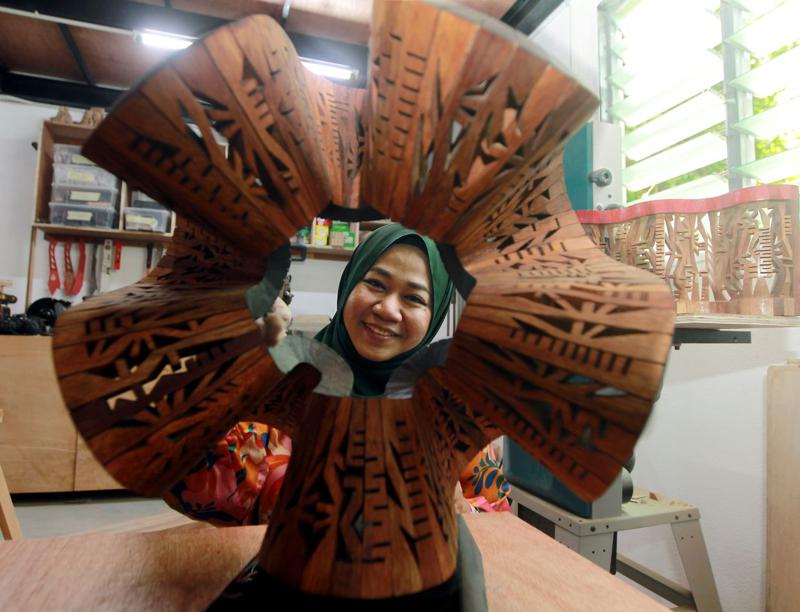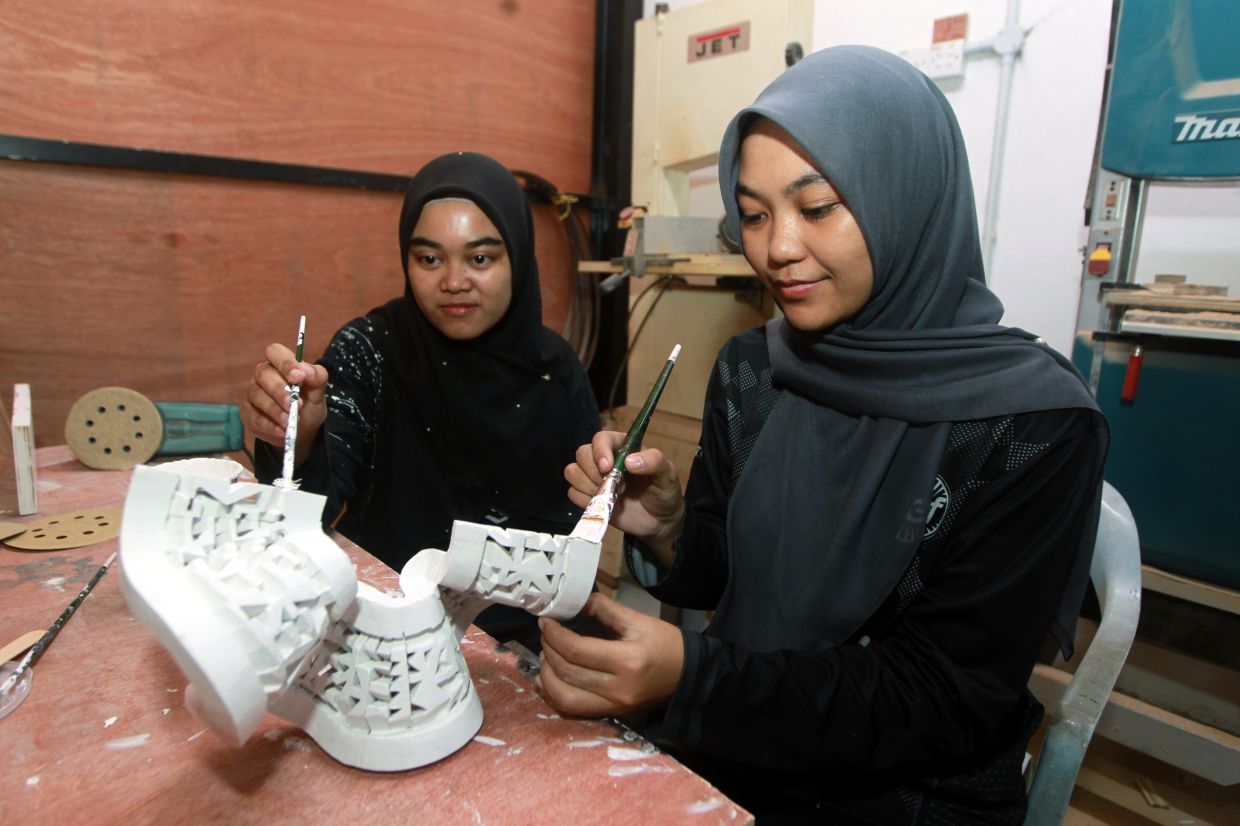ANN/THE STAR – In Malaysia, female sculptors are few, and 38-year-old Sarawakian Anniketyni Madian proudly counts herself among them.
The Kuching-born, Selangor-based contemporary artist says that the key to survival in this industry is “to be bold, strong and patient”.
“There are opportunities for women in this industry, but we have to be resilient to survive,” she says.
“If women sculptors overseas can excel in this industry, why not Malaysian women?” Anniketyni questions.
Being around people who motivate you is also crucial, she adds.
“I have survived in this field for 16 years. Women have to be adventurous and mentally strong to carve a name for themselves in this industry.
“Malaysian sculptors are a rare breed and a female one is even rarer. On the one hand, this allows us to stand out even more, but on the other hand, women face plenty of scepticism as well,” she says in an interview at her newly renovated workshop in Kg Bukit Lanchong in Shah Alam, Selangor.
Anniketyni goes on to illustrate her point with a personal story.
“Last year, I showcased my creation – a 5m x 2.4m wall sculpture titled Lagenda Puteri Santubong (LPS) at my third exhibition, Susey, in Kuala Lumpur.
“Many visitors couldn’t believe that I single-handedly crafted the huge sculpture. I frequently have to share videos and images of my studio process to dispel their doubts.
“However, I remain unfazed. I stand here on the merits of my work, driven by passion for what I do,” shares Anniketyni, who held her first and second solo exhibitions – Massive Terratory and Bejampong – in 2011 and 2017 respectively.

CHASING HER DREAM
Art has traditionally been a male-dominated space, she says, and sculpture is a discipline that has been particularly hard for women to break through. And so, the recognition of this Sarawakian sculptor is definitely noteworthy.
Anniketyni smiles as she shares how she had rejected an offer to study civil engineering at a public university to follow her passion – she enrolled in a fine arts degree programme at the Universiti (Institut) Teknologi Mara in Shah Alam instead, where she majored in sculpture.
“I hid the acceptance letter (to study engineering) from my parents,” she confesses. “I didn’t want to be forced into a career that didn’t ignite my dreams. When my parents found out, they were upset. Their biggest worry was whether I could earn a living as an artist,” she says.
“We live in a society where being a full-time artist is still met with scepticism,” she adds.
“My parents’ primary concern was whether their child would be able to support herself in the local art scene. The turning point came when I started sending money to my parents; that’s when they realised that I could support myself independently,” says Anniketyni.
Over the past 15 years, she has participated in residency programmes at Buffalo Creek Art Centre in Nevada, the United States; the World Youth Forum & Sculpture Symposium in Egypt, and the Sculpture Symposium in Armenia.
She attributes much of her success to the support of her family, especially her husband, photographer Dinn Diran.
“I’m blessed that my husband is very encouraging. Having a partner who understands your work is invaluable. It gives you the perfect environment to thrive. And my parents and my siblings are my biggest fans,” says the mother of one.
Balancing her artistic career with motherhood presents its own set of challenges, but Anniketyni approaches it positively, determined not to let herself be fazed.
“I love my daughter Mia Elena, and I enjoy spending time with her. But work is work, and I take my work seriously. I am fully committed to my art whenever I am working in the studio. I work from 9am till 6pm. Essentially, it boils down to time management,” says the artisan, who was named Top 30 for The Sovereign Asian Art Prize in Hong Kong in 2020.

HERITAGE KEEPER
Anniketyni has become a prominent figure in the local art scene and is recognised for her distinct style: Her work showcases a unique blend of material exploration, reflections on evolving craft traditions, Islamic calligraphy, and she taps into the rich heritage of Sarawakian communities.
She is of Iban heritage and draws inspiration from the intricate patterns found in pua kumbu, a traditional waft textile woven by Iban women. Her sculptures seamlessly blend traditional motifs from her heritage with contemporary flair.
“I draw inspiration from the rich culture and folklore of Sarawak. Incorporating elements like crocodiles, longhouses, and other traditional motifs into my sculptures allows me to celebrate my roots while challenging perceptions of Malaysian art.
“Themes of society and culture are always of interest to me. I find it speaks volumes about me as an artist. Artists love to have a signature look and feel to their work. I am delighted that people are slowly beginning to recognise pua kumbu as my ‘signature’. And I feel it is important to showcase this to the world,” says Anniketyni, the fifth of seven siblings.
She has created several commissioned sculptures, among the most notable ones being the wooden carvings for the Mall of Medini in Johor Baru and another piece for the United Nations offices in Rome.
Her artwork design was also selected as the plaque for the UN’s Food and Agricultural Organisation’s 2016 Corporate Art Awards in Rome.
At Susey (which means storytelling in Bahasa Melayu Sarawak), she drew inspiration from the rich folklore of her home state, along with pua kumbu, and indigenous woodworking crafts.
“The idea for Susey came in 2019, when I was pregnant with Mia. And the Covid-19 pandemic gave me plenty of time to reflect. Sarawakian folklore has always fascinated me, especially where there are several versions of it. It got me thinking about which version(s) (of these folklores) I would pass along to my daughter?
“So I revisited many of these stories that were told to me by my mother. Revisiting these stories brought back many childhood memories, and it was also a great way to reconnect with my family.”
For her exhibition last year, she integrated new materials like epoxy resin, metal, stainless steel and combined graphic stylisations of patterns to capture the cultural narratives of Sarawak. It included traditions of Sarawakian tribes like Bidayuh, Iban and Melanau.
Among the 15-pieces she showed, highlights were wall sculptures such as Kisah Mesiong (Melanau), Kaleng & Kumang Ruwai (Bidayuh), Berandau Panjai Biar Mayuh Isiknya (Iban), and Bidayuh totem-inspired Dasi & Nian. Dendam Sang Buaya was about Sarawak’s largest saltwater crocodile named Bujang Senang.
One of the signature pieces was the Lagenda Puteri Santubong wall sculpture which had a large amount of detailing. Included in the work are elements from Sarawakian heritage jewellery, stylised pua kumbu patterns as well as the state’s rich landscape, represented via the flowing ‘river’ of blue via epoxy resin.

“Sarawak is rich in culture and heritage and there are many elements that I can use for my art. As a sculptor, I want to showcase Sarawak folklore to the world.
“It was a conscious decision to include these art pieces in the exhibition.
“I try hard to avoid predictability and monotony in my exhibitions and I want to ensure that each show stands out with unique pieces,” explains Anniketyni, who took two years to complete the artworks for the Susey exhibition.
Anniketyni continues to explore new types of materials even though she is unsure of whether they will be incorporated into her future artworks.
“I used to work purely with wood. Now, I incorporate metal, epoxy resin and plastic in my work.
“I am exploring stainless steel and marble too. I enjoy working with new materials. And I think this has impacted the evolution of my style over the years.
“I am constantly working on new ideas, concepts, and materials but I will continue to celebrate Sarawak’s vibrant culture.”






